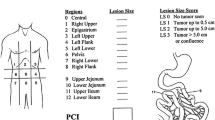Abstract
Background
Cytoreductive surgery combined with hyperthermic intraperitoneal chemotherapy (HIPEC) is an aggressive strategy to treat patients presenting peritoneal carcinomatosis from various origins. The aim of this study was to evaluate the correlation between the peritoneal cavity’s capacity and the weight, the size and the body mass index (BMI) of patients to see if it would be relevant to adapt the pharmacology of HIPEC based on these factors.
Materials and methods
This study included 100 patients who had chest-abdominal-pelvic Computerised Tomography (CAP-CT) for various reasons. They were chosen randomly (53 males; 47 females; age range 19–96; mean 58 years). Weight and height of each of them were recorded with their identity on a model sheet given to nurses accustomed to work in clinical trials, before the CAP-CT. The BMI was then calculated from these two values. All the subjects were scanned with CT (Philips Brilliance 40, Cleveland, USA) and the volume of the peritoneal cavity, the liver and the spleen of each was measured with Centricity PACS LS software or Volume Viewer 2 (AW Suite 2.0 6.5.1 u) software.
Results
The rates of correlation between the weight, the size, the BMI and the volume of the peritoneal cavity in which the volumes of the liver and the spleen were removed are 0.674, 0.317 and 0.576, respectively; and those of the weight, the size, the BMI and the volume of the peritoneal cavity without taking into account the volume occupied by the liver and spleen are 0.749, 0.348 and 0.644, respectively.
Conclusion
The peritoneal cavity’s capacity is mainly correlated with weight and the interest to assess the volume of liver and spleen remains questionable in terms of results.







Similar content being viewed by others
References
Breton E, Choquet P, Bergua L et al (2008) In vivo peritoneal surface area measurement in rats by micro-computed tomography (microCT). Perit Dial Int 28(2):188–194
Crile GJ (1963) The effects of heat and radiation on cancers implanted on the feet of mice. Cancer Res 23:372–380
Di Paolo N, Sacchi (1990) Anatomy and physiology of the peritoneal membrane. In: Scarpiano LL, Ballocchi (eds) Evolution and transin peritoneal dialysis. Karger, Basel, pp 10–26
Elias D, Bonnay M, Puizillou JM et al (2002) Heated intra-operative intraperitoneal oxaliplatin after complete resection of peritoneal carcinomatosis: pharmacokinetics and tissue distribution. Ann Oncol 13:267–272
Elias D, Matsuhisa T, Sideris L, Liberale G et al (2004) Heated intra-operative intraperitoneal oxaliplatin plus irinotecan after complete resection of peritoneal carcinomatosis: pharmacokinetics, tissue distribution and tolerance. Ann Oncol 15:1558–1565
Esquis P, Consolo D, Magnin G et al (2006) High intra-abdominal pressure enhances the penetration and antitumor effect of intraperitoneal cisplatin on experimental peritoneal carcinomatosis. Ann Surg 244:106–112
Esquivel J, Sticca R, Sugarbaker P et al (2007) Cytoreductive surgery and hyperthermic intraperitoneal chemotherapy in the management of peritoneal surface malignancies of colonic origin: a consensus statement. Ann Surg Oncol 14:128–133
Glehen O, Mohamed F, Gilly FN (2004) Peritoneal carcinomatosis from digestive tract cancer: new management by cytoreductive surgery and intraperitoneal chemohyperthermia. Lancet Oncology 5:219–228
Henderson JM, Heymsfield SB, Horowitz J et al (1981) Measurement of liver and spleen volume by computed tomography. Radiology 141:525–527
Kaneko J, Sugawara Y, Matsui Y et al (2008) Spleen size of live donors for liver transplantation. Surg Radiol Anat 30:515–518
Levy E, Parc R, Guilmet C et al (1985) Histoire spontanée ou provoquée du péritoine et des péritonites. Ann Chir 39(8):531–537
Mohamed F, Stuart OA, Glehen O et al (2004) Docetaxel and hyperthermia: factors that modify thermal enhancement. J Surg Oncol 88:14–20
Mohamed F, Sugarbaker PH (2003) Carrier solutions for intraperitoneal chemotherapy. Surg Oncol Clin N Am 12:813–824
Smeenk RM, Verwaal VJ, Antonini N et al (2007) Survival analysis of pseudomyxoma peritonei patients treated by cytoreductive surgery and hyperthermic intraperitoneal chemotherapy. Ann Surg 245:104–109
Sugarbaker PH (2007) Laboratory and clinical basis for hyperthermia as a component of intracavitary chemotherapy. Int J Hyperthermia 23:431–442
Author information
Authors and Affiliations
Corresponding author
Rights and permissions
About this article
Cite this article
Duez, A., Cotte, E., Glehen, O. et al. Appraisal of peritoneal cavity’s capacity in order to assess the pharmacology of liquid chemotherapy solution in hyperthermic intraperitoneal chemotherapy. Surg Radiol Anat 31, 573–578 (2009). https://doi.org/10.1007/s00276-009-0483-1
Received:
Accepted:
Published:
Issue Date:
DOI: https://doi.org/10.1007/s00276-009-0483-1




